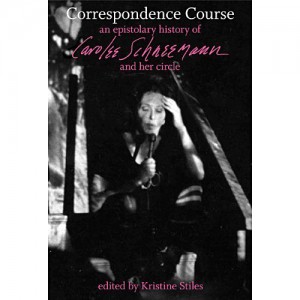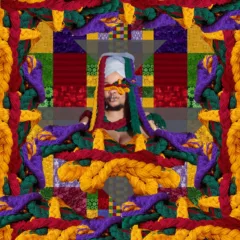Women have been behind many of the significant developments in the art of the past fifty years: bodily-based work, contemporary performance art, artist-run spaces, and various alternative art forms such as artists’ books and temporary installations. Yet major museums have been slow to acknowledge them, and until recently no monographs existed on the work of numerous important figures. The past few years have shown signs of change, with books appearing on major artists whose careers began in the 1960s and 70s. Several recent collections of writing by these women add immeasurably to our understanding of the ideas and efforts behind their art, and provide insiders’ views of the social conditions in which they worked.
Correspondence Course; an epistolary history of Carolee Schneemann and her circle, Kristine Stiles, ed. (Duke University Press, 2010) ISBN 978-0-8223-4511-4
Of the various ways to record one’s own life, correspondence often makes the most interesting reading since it evolves in real time and is outward directed. Readers interested in art since 1960 will be grateful that Carolee Schneemann was a serious correspondent, keeping up with a wide range of colleagues, and more remarkably, making carbon copies of her letters. She was also a serious and introspective writer; still an undergraduate, she wrote I decided to write, since it’s so much like a letter to myself were I someone else. Several volumes of Schneemann’s writing exist, some out of print, but a major monograph on her work has yet to appear.
This collection of her correspondence and responses from almost 80 friends and colleagues gives a vivid idea of the struggle to establish herself in the art world of the 1960s, and her ongoing efforts to develop original and provocative work over forty years (the volume ends with letters from 1999). Schneemann, one of the most significant, radical, and adventuresome artists of the period, has made crucial contributions to performance art, multi-media work, installations, film, and feminist-based practice. She had a remarkable confidence in herself as an artist at a very early age, which was crucial, since she often received withering dismissal from a then entirely-male art establishment, and still has not received the attention her work deserves
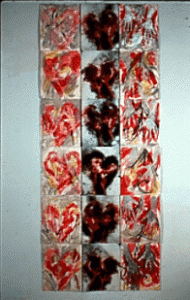
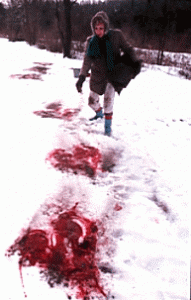
Her work also met with occasional incomprehension from audiences, sensational responses from the press, and even police intervention. Kristine Stiles has edited the large body of correspondence (now in library collections, but previously unpublished) with an emphasis on Schneemann’s evolution as an artist, and Schneemann made no attempt to control or edit the selection, which reveals disagreements and fights with colleagues, as well as cooperation and mutual support.
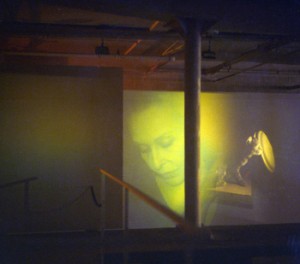
Stiles provides a thoughtful introduction and annotations, which clarify references to people, places and events. She has also included reproductions of newspaper and magazine articles and printed ephemera along with illustrations of Schneemann’s work, which situates the art in relation to its public reception, and forms a counterpoint to the personal responses of the many artists, composers, dancers, poets and thinkers with whom Schneemann corresponded. These include Stan Brakhage, Yvonne Rainer, Allan Kaprow, Joseph Cornell, Hannah Arendt, and Dick Higgins. The more recent letters include increasing correspondence with curators, critics, and art historians, a reflection of increasing acknowledgment of Schneemann’s importance; these include Pierre Restany, Thomas McEvilley, Peter Selz, Lawrence Gowing, Henry Sayre, and Kristine Stiles, who edited the volume.
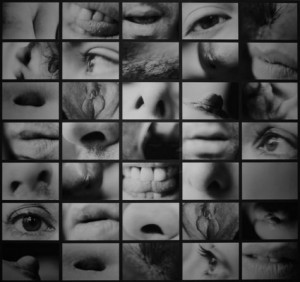
Schneemann’s performances often involved the participation of other artists, and the letters are filled with details of the social and logistical challenges this entailed. They also record her ongoing struggle to survive while creating work that had no market value, even long after her reputation was secure. Her financial predicament is made poignantly clear in the final letter, to the director of the McArthur Foundation’s Fellows Program, which never supported her work. This volume is an extremely valuable record of the life, thoughts, working conditions and friendships of an important artist, and gives an inside view of the art world during a time of major changes. It also presents a valuable visual record of the period, and will be an essential resource for scholars; it may well become required reading for artists as well.
Carolee Schneemann in Philadelphia, April-May, 2012
The Slought Foundation and College of Physicians are bringing Schneemann to Philadelphia for a series of programs from April 24 – May 31, 2012, beginning with a conversation with the artist on April 24, 2012, 6:30pm at The College of Physicians of Philadelphia. Further details are on both organizations’ websites.


